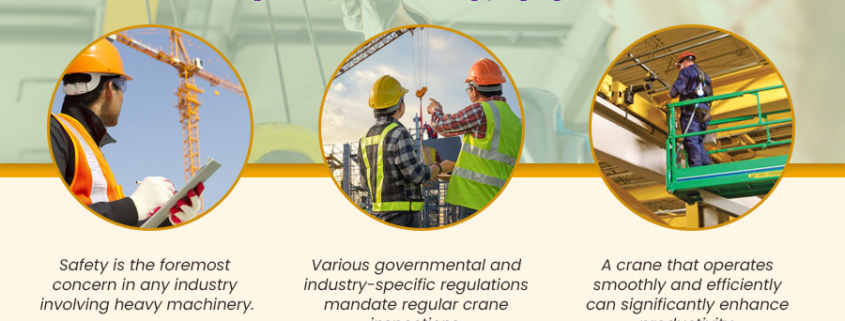Crane Inspections Austin Guide: How Often Should You Inspect Cranes & Equipment
Cranes and heavy equipment are the lifeblood of many industries, from construction to manufacturing. They perform the heavy lifting that allows projects to move forward, often under challenging conditions. However, with great power comes great responsibility.
Furthermore, with Crane Inspections Austin ensuring that cranes and equipment are regularly inspected is crucial for maintaining safety, operational efficiency, and compliance with regulations. But how often should these inspections occur? Let’s dive into the details.
The Importance of Regular Inspections
Regular inspections of cranes and equipment are essential for several reasons:
Safety: The most important reason for regular inspections is to ensure the safety of everyone on the job site. Cranes and heavy equipment are massive, powerful machines that can cause significant harm if something goes wrong. Regular inspections help identify potential issues before they lead to accidents.
Compliance: Regulatory bodies such as OSHA (Occupational Safety and Health Administration) have strict guidelines for the inspection of cranes and heavy equipment. Failing to comply with these regulations can lead to hefty fines, legal issues, and project delays.
Efficiency: Regular inspections help ensure that your equipment is operating at peak efficiency. Identifying and addressing issues early can prevent costly breakdowns and downtime, keeping your projects on schedule.
Longevity: Properly maintained equipment lasts longer, providing a better return on investment. Regular inspections can help extend the life of your cranes and heavy equipment by identifying wear and tear before it leads to major failures.
Types of Crane Inspections
There are several types of crane inspections, each with its schedule and focus. Understanding the different types of inspections can help you determine how often your equipment should be checked.
Initial Inspection
When: Before a crane is used for the first time or after it has been altered, repaired, or modified.
Purpose: To ensure that the crane is safe to operate and complies with all relevant regulations. This inspection is thorough and covers all aspects of the crane’s operation.
Frequent Inspections
When: Daily or monthly, depending on the crane’s usage and environment.
Purpose: To check the crane for any visible signs of damage or wear, such as cracks, deformities, or leaks. These inspections are typically less formal but are crucial for identifying issues that could lead to more significant problems if left unaddressed.
Periodic Inspections
When: Annually or quarterly, depending on the type of crane and its usage.
Purpose: These are more in-depth inspections that cover all aspects of the crane’s operation, including its structural integrity, electrical systems, and load-bearing components. Periodic inspections are often required by law and must be documented.
Operational Inspections
When: Before each use.
Purpose: These are quick checks to ensure that the crane is functioning correctly. Operators should check controls, brakes, and other essential systems to ensure everything is in working order before beginning a lift.
Post-Incident Inspections
When: After a crane has been involved in an accident or near-miss.
Purpose: To determine if the crane has been damaged and if it is safe to continue using it. These inspections are critical for preventing future accidents.
Factors Influencing Inspection Frequency
With Equipment Inspections Austin considers several factors that can influence how often cranes and equipment should be inspected:
Type of Crane: Different types of cranes have different inspection requirements. For example, overhead cranes may need more frequent inspections than mobile cranes due to their different operating environments and stress factors.
Usage: The more frequently a crane is used, the more often it should be inspected. Cranes used in heavy-duty operations, such as lifting heavy loads or operating in harsh environments, may require more frequent inspections than those used for lighter tasks.
Environment: Cranes operating in extreme conditions, such as high temperatures, corrosive environments, or areas with high levels of dust and debris, may need more frequent inspections. Environmental factors can accelerate wear and tear, making regular inspections essential.
Manufacturer’s Recommendations: The crane manufacturer’s guidelines should always be followed when determining inspection frequency. These recommendations are based on the specific design and capabilities of the crane.
Regulatory Requirements: Different regions may have different regulations regarding crane inspections. It is essential to be aware of and comply with local, state, and federal laws governing the inspection of cranes and heavy equipment.
Best Practices for Crane Inspections
To ensure that your crane inspections are effective, consider the following best practices:
Follow a Checklist: Use a detailed checklist during inspections to ensure that all critical components are examined. This helps to avoid overlooking any potential issues.
Document Inspections: Keep thorough records of all inspections, including who performed the inspection, what was checked, and any issues found. This documentation is crucial for compliance and can be valuable in the event of an incident.
Train Your Team: Ensure that all personnel involved in crane operations, including operators and inspectors, are adequately trained. They should be familiar with the specific equipment they are working with and understand how to conduct inspections properly.
Use Qualified Inspectors: Inspections should be performed by qualified individuals who understand the equipment and are familiar with the relevant regulations. For periodic and annual inspections, it may be necessary to use a certified third-party inspector.
Act on Findings: If an inspection reveals issues, address them immediately. Do not operate the crane until any identified problems have been resolved. Proactive maintenance can prevent accidents and extend the life of your equipment.
Conclusion: Prioritize Safety Through Regular Inspections
Regular inspections of cranes and heavy equipment with Crane Inspections Austin are not just a regulatory requirement—they are a critical component of a comprehensive safety and maintenance program. By conducting inspections at the appropriate intervals and addressing any issues promptly, you can ensure the safety of your team, extend the life of your equipment, and maintain compliance with regulations.
Remember, the frequency of inspections depends on various factors, including the type of crane, its usage, and the environment in which it operates. By staying vigilant and adhering to best practices, you can keep your operations running smoothly and safely.
For more information on crane inspections and to schedule your next inspection, reach out to our team of experts today. Prioritize safety, and keep your operations lifting strong.




